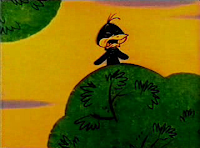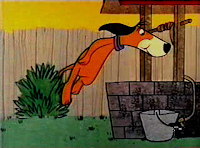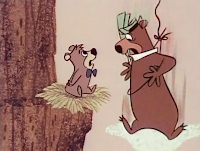 Not too many days ago, having read a post on John Kricfalusi’s blog, I jumped in the WABAC machine (if I may mix my TV animation for a moment), and leisurely journeyed through the Saturday morning TV cartoons of the 1960s and early ‘70s, explaining why I stopped viewing them. My perspective is that of an anxious fan in the pyjamaed pre-teen and teenaged years. It’s the only perspective I have because I haven’t seen much of the cartoons for about 40 years.
Not too many days ago, having read a post on John Kricfalusi’s blog, I jumped in the WABAC machine (if I may mix my TV animation for a moment), and leisurely journeyed through the Saturday morning TV cartoons of the 1960s and early ‘70s, explaining why I stopped viewing them. My perspective is that of an anxious fan in the pyjamaed pre-teen and teenaged years. It’s the only perspective I have because I haven’t seen much of the cartoons for about 40 years.
That period of animation isn’t the focus of this blog but my thoughts were a bit long for the comment section of John’s site, so I put them here.
Readers weighed in for a nice little discussion and I thought it had wound up, but then I got an e-mail. Someone else had thoughts on the subject that were a little long for the comment section here, so he wrote me with what he had to say.
His perspective is different than mine. I was a viewer. He was one of the people who hoped to entertain viewers through art, movement and humour. So I’m putting up this e-mail by ‘loopydloop’ (with his permission) so he can offer his feelings from the vantage point of being employed by Hanna-Barbera. (He’s responsible for the text only; I added the screen caps).A Long Comment From MeBy loopydloop

The discussion about the downfall of the H & B Cartoons is extremely interesting, as are many of the topics and discussion brought up on the YOWP Blog. I will admit, here, that I am a 50 year old product of the early Hanna Barbera years and have a great affinity for those wonderful cartoons, warts and all. You see, even as a small child in the early 1960s I could tell the difference between the Hanna Barbera cartoons and the classic cartoons from MGM, Disney, Warner Brothers, etc. I even knew the difference in the quality of animation in the title sequences and commercials from H & B in comparison to their main shows and certainly the difference between Ludwig Von Drake compared to other television animation. But I didn't care. There was just something appealing about the Hanna Barbera shows of that time that really captivated me and does so to this day. Sadly, as I grew older, the quality of the Hanna Barbera cartoon continued to degenerate to the point where each new "Super Saturday" preview on the networks brought more and more horror to the small screen. Eventually, they lost me. I just couldn't watch any more and didn't until, in the early 1980s, I began to actually work on the stuff.
As I read down the column of blog comments, there were many well thought out posts about the sad slide in the quality of the Hanna Barbera product, but no one really touched upon two important factors, from the late 1960s to the 1980s, that I feel contributed to H & B's, (and other studios) decline.

The first blow to Hanna Barbera studios was, ironically, the same factor that lead to it's success, the demand for more and more programming. This demand, though profitable for the studio, caused greater production and a need for more animators and other artists. The experienced animators and artists (Ed Benedict, Dick Bickenbach, Walter Clinton, Carlo Vinci, Lew Marshall, Don Patterson, Irv Spence, Ken Muse, Mike Lah, etc. etc.) who had followed Bill and Joe over from MGM, and the later influx of cast off animators, (Hicks Lokey, Dick Lundy, Hugh Frasier, Harvey Toombs, Bill Keil, Hal Ambro, etc.) who also went over to H & B after the big layoff at Disney in 1960 (at the wrap of Dalmatians) were just spread too thin. So, assistant animators, the majority of whom had no full animation experience, were soon promoted to animator and animation began becoming less imaginative and more formulaic as time and talent battled to produce the sheer volume of animated material needed to feed the ravenous appetite of television. Factor in the aging process of the 1930s and 40s animators, now in their declining years, and the boring, repetitive work that television animation came to be and you can certainly see why things went downhill fast! But that wasn't all.

The second big blow to the Hanna Barbera cartoon was when Bill and Joe started sending animation overseas in the 1970s to have it done more cheaply by animators who, due to cultural, language, and animation style differences (though I'm sure they tried their best), could not compete with the experts that once graced the discs at Hanna Barbara. At first, only the animation was being sent out of the country, but increasingly, other departments followed suit, and soon whole shows were being done by foreign artists. There were still shows such as "Help, It's the Hair Bear Bunch" being done "in house" by experienced animators, but even the lack luster concept, quality and writing of that show eclipses it's contemporaries from overseas such as "Funky Phantom" and the like.
So, ultimately, I feel that it was greed, the sheer volume of work and the lack of training for the younger artists that ultimately brought down the quality of television animation, which brings up another point I wished to address from a professional perspective, and that would be the comments made by one person, above, about the age of the viewer influencing the era of Hanna Barbera cartoons they enjoy. This may be partially true, but the cold hard fact is that the cartoons that came out of Hanna Barbera in the 1970s and 1980s were really dreadful on every level. They were blandly conceived, terribly written and horribly produced and, furthermore, nearly everyone involved in the making of those show knew it. The writers knew it. The voice talent knew it. The animators knew it. A young assistant just starting out (like me) knew it. Even Bill and Joe knew it. In fact, the only people that didn't seem to know it were the poor innocent children this dreck was perpetrated on.

To this same commenter, I would like to add that it is absurd to think, even for a moment, that Hanna and/or Barbera had any desire whatsoever to keep the employees in the U. S. working, at least not by the 1970s. The truth is, Bill and Joe didn't even own the company by this time. Their loyalty was now to the shareholders of TAFT and the bottom line. To that end, they couldn't ship the stuff overseas fast enough, even over the loud protests, lawsuits and bitter strikes brought up by the Motion Picture Screen Cartoonists Local 839 to stop the wholesale selling out of the work to cheap foreign labor before the term "outsourcing" was even coined. Hanna Barbera was also the first studio to start using computerized painting systems in the 1980s, which directly resulted in the lay off of the majority of what was left of the ink and paint department since they had long since sent most of that labor overseas anyway. So, with all due respect to that commentator who felt that the studio just wanted to keep people employed, I just have to say.... Are you kidding?
Yes, it's happened before, it's happening now, and it will most likely happen again. It's simply human nature. Animation that starts out as a labor of love, often falls prey to greed and outrageous profit and then goes down the tube in the form of a sweatshop, cranking out crap at supersonic speed for children too ignorant or innocent to know the bill of goods they are being sold. The good news is that each new generation brings about a new crop of young artists who really care about animation, those dedicated to making things better and to bringing quality back to screens everywhere, large and small. So I put my hope in them. I teach the strong foundations of animation that I was taught by the masters themselves and I hope that this new generation of artists will keep the torch burning for another generation. The promoters and the corporations and the greedy will always be there, feeding upon the art form and then leaving the carnage of their avarice behind. But, then, so will the artists and the historians and the fans who will quietly pick up the pieces, remembering and cherishing what animation was, imagining what what it can be and nurturing it back to life for a future generations to discover and enjoy.
Thanks, loopydloop, for putting down your thoughts.
I can’t help but wonder if the original H-B artists considered their work uncreative drudgery, considering they went from beautifully flowing and expressive animation to minimal, basic movement. If so, they should have felt some satisfaction that they helped to create some enjoyable cartoons and likeable characters that overcame the limitations of television budgets. For a while. Though I admit that’s a personal opinion. To each his own. If the bankrupt cartoons of the ‘70s and ‘80s provided entertainment to someone—and, judging by comments elsewhere on the web, they did—then their animators should at least accept that as a bit of satisfaction for their work over a generation ago.
Yowp Note: Since this post went up, Greg C. has sent me his own essay on the subject. So I have added that below:Hanna-Barbera in the 1970's
By Greg C.It's too bad loopydloop's bubble was burst by working for Hanna-Barbera, but in defense of H-B, a business is a business. Profit is what the company makes on revenues over expenses to be able to put back into the business to keep the business going. Without profit, the business cannot survive; it's that simple.
I did not understand all of this business jargon growing up while watching the same cartoons as loopydloop, but as I grew older I realized that there is a big difference between theatrical animation (or full animation) and TV animation (or limited animation). They are two different styles of animation that have to be looked at independently and not in congruence with each other and they come with two very different business models.
I have studied all aspects of television since I was a little kid - scheduling, programs, types of shows, program blocking, genres, etc. Limited animation is made to feed the TV module. It has to be done cheaply and efficiently in order to meet the demand by the networks and to be supported by advertising revenue. There is nothing artistic about this model at all. All TV shows are funded much cheaper than theatrical motion pictures. The budgets are much, much smaller for television and the product has to be churned out quick and fast. Everyone is working on a deadline.
TV programs are bought either by networks or syndicators and they recoup their financial investment through advertising. Usually, when an episode will first air, the cost of the advertising pays for the cost of that first broadcast; there is no profit for running an episode only once. It is when the episodes are repeated that the network starts to make some money on the program. If the network can sell it to a cable network or syndicator, then they are really rolling in the dough. When the show is sold like this, not only does the network prosper from repeats but the studio does as well.
If a studio can sell a show directly into syndication, then they can cut out the middleman (the network) and generate more profit for themselves. However, the financial burden is now on the studio and they have to not only sell the show to a syndicator but they also have to sell it to sponsors and local TV stations to generate revenue to pay for the show. There is more financial risk this way for the studio, but if they can get a hit (Huckleberry Hound, Star Trek: The Next Generation, Oprah Winfrey), then the studio can make lots of money.
When Huckleberry Hound, Quick Draw McGraw and Yogi Bear first showed up, H-B had a sponsor in Kellogg’s and sold these shows into syndication. These cartoons did very well, but H-B was limited in the amount of work that they could produce because they only had one customer, syndication. However, when the networks started to ask for shows, that’s when H-B started to really take off. More customers mean more demand and more work. The Flintstones, the Jetsons, Jonny Quest and Top Cat were all sold to ABC for primetime, but three of these shows only lasted one season. Top Cat and the Jetsons did not bring about the ratings success like the Flintstones did so they were cancelled. Jonny Quest was mildly successful, but it was too expensive to make so it was dropped.
Around this same time, network television really started to take off in the late 1950’s and 1960’s and syndication was a dying format; it would start to resuscitate in the early 1980’s when cable programming came along. It was much cheaper for local TV stations to air first run programs from networks than it was to have to purchase shows out of their own pocket. Saturday mornings started to be the target of the networks for children’s programming. So, with three dropped shows in primetime programming and with the syndication market drying up for a period of time, Hanna-Barbera had to find a way for their business to survive. Bill and Joe saw the handwriting on the wall and in order for their business to survive they made two major decisions. They decided to sell their business to Taft Broadcasting and to start targeting their shows to the Saturday morning crowd.
I am not privy to any special information but I wouldn’t be surprised if part of their decision to sell the studio came from partly from desperation. Just ten years before in 1956, Bill and Joe were out of work because of layoffs at M-G-M and if the TV animation market was drying up, by selling the business they could pocket millions and retire. If TV animation continued to survive, then they could still be employed. Like I said, this is speculation on my part, but I wouldn’t be surprised if this was part of their motivation for selling H-B Productions.
When Saturday mornings opened up to new animated shows, the business model went off the charts and production soared. The networks were able to purchase shows for a fair price, but they also kept the number of episodes ordered to around seventeen. This way, they could repeat the same episode three to four times in a year and make even more money from the programming. The animation studios could also make good money for each repeat of their programs. Primetime episodes generally aired only twice a year but on Saturdays the number of repeats meant good profit margins for everyone.
However, thanks to Jonny Quest being in reruns on NBC on Saturday mornings, parental groups stepped in and demanded less violence and more educational programming for children. The networks did not want to lose their cash cow on Saturdays, so they agreed to cater to the parental groups and provide entertaining but also educational programming. The networks hired psychologists to monitor each and every show on their schedule to make sure that it was falling into these parental parameters. The animated studios had to acquiesce if they wanted to stay in business.
As it turns out, Hanna-Barbera provided the most programming on network television in the 1970’s and 1980’s. H-B could meet the demand for episodes that the networks requested and they were able to deliver the product at an affordable price. I totally understand why people complain that when they got to a certain age that they could not watch H-B shows any more. The viewer realized that it wasn’t geared towards their age group and then they turned off the TV. H-B turned out shows that were made to meet the target age group that the networks requested; it was never meant for the general population. Also, H-B was a business and if the studio did not get work, then it would go out of business, plain and simple.
Animation in the movies and in television was never made for the sake of art. It was always made to bring in revenue to help keep the studio afloat. When the cost of making movies went up in the 1950’s along with the advent of television, the studios decided to start making cuts and animation was one of the biggest cuts that they made. Animators turned to television to continue to be employed but also in order to stay in business; and to stay in business they had to make money. Profit is what the business makes to be able to put back into the business to make it stay in business. There is nothing wrong with profit. It is the driving machine that is keeping studios in business today.




















































